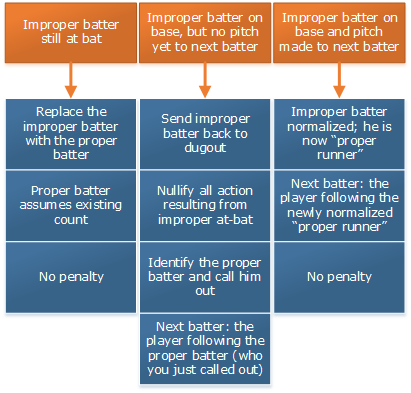 Batting Out of Order
Batting Out of Order
Few baseball rules are dealt with incorrectly more frequently than batting out of order. The applicable rule is 6.03(b), which was last revised (and clarified) in 1957. So the rule has been around for a while.
The rule, penalties, and remedies for batting out of order are not difficult to understand. The tricky part is fixing a batting-order infraction once an appeal is upheld. The plate umpire owns this one since the plate umpire owns the lineup.
Note: For an interesting read about the history and confusion surrounding this rule, see an article in the SABR Research Journal entitled, fittingly enough, Batting Out-of-Turn Results in Great Confusion, written by Mark Pankin.
Let's start by clarifying two terms essential to discussing batting out of order: proper batter and improper batter.
- Proper batter. The correct batter at bat with respect to the official lineup. To belabor the obvious, there is always just one (and only one) proper batter at any given time.
- Improper batter. Any offensive player other than the proper batter who is at bat.
When untangling a batting-order infraction, only two batters matter: the batter who is presently at bat, and the player who batted previously. We'll see why shortly.
Important: Batting out of order is an appeal play. You should never point out an improper batter on your own initiative, nor should you let the scorekeeper or anyone else "outside the fence" have any say. Only members of the team on defense can ask for time and appeal a batting order issue, although the offense can ask for time and rectify the mistake while the improper batter is still at bat.
The Appeal
A batting-out-of-order appeal begins with the defense asking for time. The manager approaches the plate umpire and claims there is a batting-order infraction. At this point you consult the the official lineup (which is the one that you carry) to establish whether a player batted (or is batting) out of turn.
A batting order infraction presents itself in one of three ways:
- An improper batter is currently at bat and has not completed his turn at bat.
- An improper batter has completed his turn at-bat, and a pitch has been thrown to a batter following the improper batter.
- An improper batter has completed his turn at bat, but a pitch has not yet been delivered to a following batter.
Note: Frequently, what appears to the defense to be a batting-order infraction turns out to be confusion caused by an unannounced substitution [ 5.10(j) ] Be alert for that.
Remedies and Penalties
If upon consulting the lineup you confirm that any one of the three cases applies, you have a batting-order infraction and you should uphold the appeal. You must then take one of three courses of action, depending on which of the three cases applies.
- The improper batter is still at bat. If you confirm that the player currently at bat is an improper batter, you must do two things:
- First, send the improper batter (who is currently at bat) back to the dugout.
- Next, call the proper batter to the plate. The proper batter assumes the count (if any) that was on the improper batter. That's it. Play on. There is no penalty if the infraction is discovered while the improper batter is still at bat, or until a pitch is delivered to a batter following the improper batter.
- A pitch has been delivered to the batter following the improper batter. If you confirm that an improper batter has just completed a turn at bat and the following batter, who is now at the plate, has received one or more pitches, the defense is out of luck. Once a pitch is delivered to the batter following an improper batter, then the improper batter (whether on base or in the dugout, if he's been put out) is now "normalized." That batter is now (retrospectively) the proper batter. The lineup, then, continues with the newly normalized batter and follows the official lineup from there. Important: The matter of normalizing an improper batter, and then establishing the correct batting order moving forward, is where a lot of mistakes are made.
- The improper batter has reached base or otherwise completed his at-bat. If you confirm that an improper batter has completed his turn at-bat (and either reached base by any means, or has been put out) but there has not yet been a pitch delivered to the batter following the improper batter, then take the following steps:
- First, consult the lineup and identify the proper batter (the player who failed to bat in his turn in the lineup); call that player out. (You do not call out the player who batted improperly, rather. it's the player who failed to bat in his turn that you call out. This is another common mistake.)
- Next, nullify any action that resulted from the improper batter's at-bat. If the improper batter is on base, you must send him back to the dugout. If other runners advanced as a result of his at-bat, return those runners to the base they occupied when the improper batter advanced. If the improper batter was put out, the out is also nullified and comes off the board. (Note: If a runner advanced by stealing a base during the improper at-bat, that runner's steal stands.)
- Finally, call the next batter to the plate. The next batter is the player whose spot in the lineup follows that of the proper batter who failed to bat in turn, whom you've just called out, and the batting order continues normally from there. If the batter who is now due up is already on base, then simply pass over him and move to the next player in the batting order.
Important: If the improper batter's at-bat results in his being put out, and if the defense then appeals the batting order infraction, that put-out is nullified. The defense gets the out from the batting out of order infraction, but they don't also get the put-out on the play. Taking it one step further, if the improper batter's at-bat results in a double-play, an appeal of the infraction nullifies both of those outs. In short, a defensive manager is wise to know this rule well, since sometimes it's best to just leave well enough alone.

Summary
This all sounds somewhat confusing, but if you learn the rule and approach it systematically you can usually untangle it without too much trouble. Also note that 6.03(b) Approved Ruling includes several example scenarios. These are useful learning tools.
The flow diagram on the right summarizes how to handle each of the batting-out-of-order scenarios:

